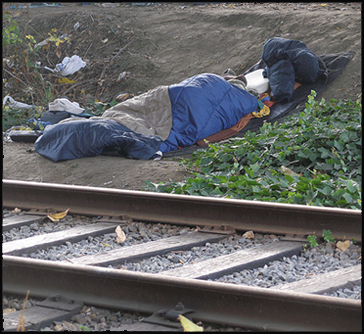
The microcosm reflects the macrocosm. In other words, one way to get a real grasp of a national problem such as homelessness is to look at a snapshot of a particular place at one point in time. That is exactly what Elliott Blackburn, a reporter for the Lubbock Avalanche-Journal, provides. In a piece called “Homeless committee braces for quick pace, tough problem,” he outlines the position this Texas city of about 220,000 souls finds itself in at the end of 2010.
In Lubbock, there is a new homeless committee, and Lynn McClendon is chair. There are 16 other members, including church custodian and former homeless person Toby Billings. The group plans to meet twice a month. What they aim to do first is figure out exactly what kind of problem Lubbock is faced with because, as Blackburn notes,
Homelessness can include everyone from someone forced to live on the streets to a person who has to stay with friends and family for some period of time, making it difficult to put a firm figure to the problem in the city.
A mutually agreed definition isn’t always easy to come to, but anyone staying in a shelter or a transitional housing facility, or any other place not intended to be a permanent home, is generally defined as homeless.
A survey was conducted, which identified 719 people experiencing homelessness in Lubbock, with three-quarters of them newbies and relatively unfamiliar with the world of homelessness, because they just entered it for the first time within the last three years.
As in most places, the homeless population of Lubbock includes a good number of the working poor. About 20% are day laborers or some other kind of part-time workers, and about another 20% work regular, full-time jobs. And yet, they are homeless! Obviously, a paycheck is not the same as a living wage, not even for people who are actually working 40 hours a week or more.
This is something that housed people with good-paying jobs often fail to wrap their heads around. Some folks complain or rage because they have to give up their vacation home. They don’t have a clue what it’s like to have no home at all, and certainly find it difficult to understand that it is possible to work full time and still not be able to afford housing.
Richard R. Troxell, president of House the Homeless, has written a document called the Protected Homeless Class Resolution. The full text is found in Looking Up at the Bottom Line, and here are a few of the points he makes:
— There is a shortage of affordable housing stock nationwide.
— The national minimum wage is an insufficient amount of money to secure safe, decent, affordable housing even at the most basic financial level.
— More than the minimum wage is required in every state to be able to afford a one bedroom apartment at Fair Market Rent, as set by the U.S. Department of Housing and Urban Development.
— The combined effect of these and other circumstances create a group of people that have no alternatives to living on the streets of our nation; and
— It is estimated that nationwide, there are at least 760,000 persons living without a permanent, fixed, individual residence on any given night.
As in any other city, resources for the homeless are not always easy to access. In this particular city, food is not a problem, but shelter is, and there is a need for a day center. One thing that almost everyone agrees on is the need for more centralization and coordination, and Blackburn captured a marvelous quotation from committee member Doug Triplett, who likened the various efforts to a bunch of free-range horses, saying,
If somehow we can harness all these, put the horses behind one thing, we can pull a stagecoach.
Coordination appears to be the trend in the state, with the Texas Homeless Network showing the way. THN is a nonprofit organization that provides training and technical assistance to the people and agencies working to end homelessness. Its mission is,
Providing solutions to end homelessness in Texas communities through education, resources and advocacy.
THN also keeps track of statistics, recording, for instance, the fact that this summer 719 people were identified as experiencing homelessness in Lubbock.
One of the training programs is Stepping Stones to Recovery, or SOAR, where staff members and benefits specialists learn how to help homeless individuals apply to receive federal social security and disability benefits. This is no easy task, especially for people who are mentally affected. Even a person with ordinary mental capacity can be so jangled and confused by finding themselves homeless that dealing with a bureaucracy and a pile of paperwork is a daunting task.
Holding onto all the necessary and required paperwork is no easy thing either. When you have to carry around everything you own, even paper gets heavy. Rain falls, and everything is soaked, and all your documents turn to pulp. Or somebody steals your backpack.
THN holds an annual conference, and mostly it trains the providers of homeless services all over the state. There is a training manager — the job is currently open — who travels about 1/3 of the time, teaching the local workers how to help the homeless.
Reactions?
Source: “Homeless committee braces for quick pace, tough problem,” LubbockOnline, 12/07/10
Source: “What We Do,” THN.org
Image by quinet (Thomas Quine), used under its Creative Commons license.


